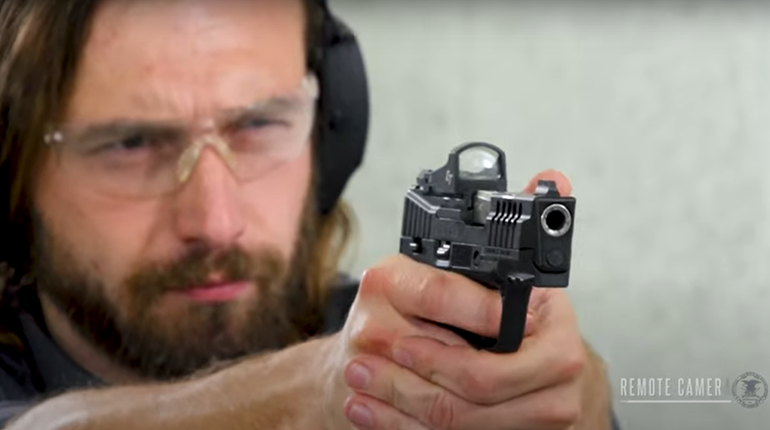
Some pistols blur the lines between those made for competition and those made for concealed carry. Sharing features with the competition-oriented P320 X5 Legion, SIG Sauer’s carry-size P320 XCompact is perhaps most exemplar of this approach where defensive pistols are designed to perform as well on the street as they do on the range.
The XCompact is modular with the firing mechanism contained in a serial-numbered, stainless steel chassis that can be inserted into different grip frames and used with different-length slide assemblies. A double-action pistol, pressing the trigger fully cocks then releases a partially tensioned striker.
Included are the defining features of “X-type” P320 pistols: extended-beavertail grip frame with wide radius, undercut trigger guard, optics-ready slide, X-Ray3 day/night sights, ambidextrous extended slide-catch levers and a flat-face trigger.
The grip features crinkle texturing on the sides and on the bottom portions of the front and backstraps, as well as a hole at its base for a lanyard. The trigger guard is long enough to accommodate moderately thick gloves without accidentally activating the trigger and has an angled, serrated front for those who prefer to wrap it with their support-hand index finger. Rounding out the frame, the dust cover allots 1.5 inches of slotted rail for mounting a light or laser.
The slide has beveled forward edges to facilitate holstering and the interior of the ejection port is cut at an angle for more reliable ejection. It is also cut to accept SIG’s Romeo1 Pro and Leupold DeltaPoint Pro red-dot sights. Because the rear sight is mounted to a plate that fits into this cut, you can run iron sights or a red dot, not both. The breechblock has a loaded-chamber flag that protrudes upward enough to visually and tactilely verify chamber status. The XCompact disassembles without having to pull the trigger, but the method is deceptively conventional, so be mindful to completely follow the directions.

Fixed, night sights on the gun are steel. The front has a tritium insert surrounded by a green polymer ring while the rear has an insert inconspicuously embedded on each side of the square notch. The front sight can be drifted to adjust windage, while the rear sight’s leading edge is high enough to rack the slide by pressing it against a belt buckle or holster if one hand is injured.
Accuracy tested with three loads and function tested with three more offerings, 400 rounds were fired without any stoppages. The sights were well regulated for a center hold printing only .75 inch to 1.25 inches above POA, but dead-on for windage.
It performs well in practical single-handed shooting where the most important design elements of a handgun—trigger, sights and grip fit—work harmoniously to make me a much more capable shooter.
The trigger’s flat, wide face reduces the perceived weight of pull while the 90-degree break combined with zero overtravel reduces the tendency of hinged triggers to induce muzzle dip. Moreover, the straight trigger face allows the shooter to adjust the perceived weight of pull; pressing at the middle yields a measured 6-pound pull while pressing at the bottom edge reduces it to 4 pounds, 2 ounces due to the increased leverage, but adds an inconsequential amount of perceived travel.
I was impressed by the X-Ray3 sights, which work well in different lighting conditions and engender rapid, correct alignment. In daylight, your attention is drawn to the green ring on the front sight, while the small tritium vials at the rear blend into the sight blade without distracting your focus, as white dots often do. The moderately wide front blade is paired with a rear notch of optimal width, and the curvature of the top of the slide creates the illusion that the front sight’s green circle is floating above it. In darkness, the front sight emits a larger green glow distinct from the smaller glowing dots at the rear.

This pistol points on target instinctively for those used to the M1911’s grip angle, and the extended beavertail helps you obtain a correct grip when drawing from a holster. Controls are easily accessible with a mag-release button of ideal size and slide-catch levers that extend slightly outward from the frame are a welcome improvement over nearly flush-mounted, difficult-to- manipulate alternatives.
Though the XCompact is more refined than most polymer carry pieces, I found two areas for improvement. The magazine’s witness holes are on the right side, making a quick load check only possible with the pistol held in the left hand, and the slide-catch levers could be made more substantial on the inside of the frame out of concern that they bend after many cycles of depressing them to chamber a round from slide lock. Other than those quibbles, this is a fine choice for carry, home defense and even some action competition.






































